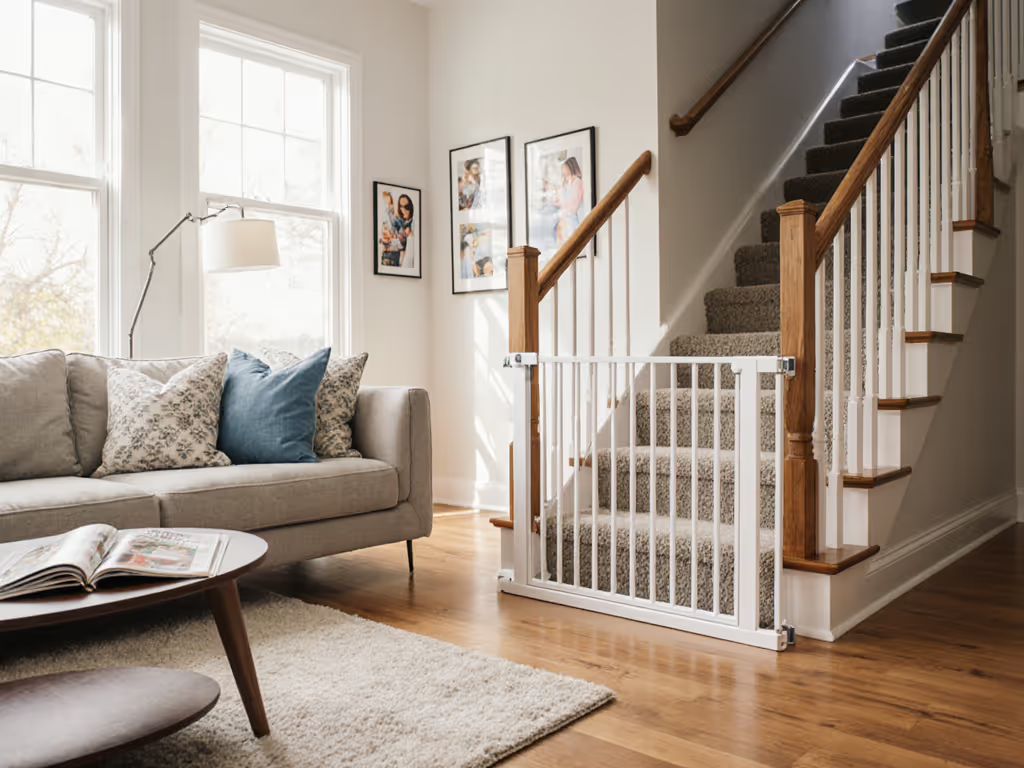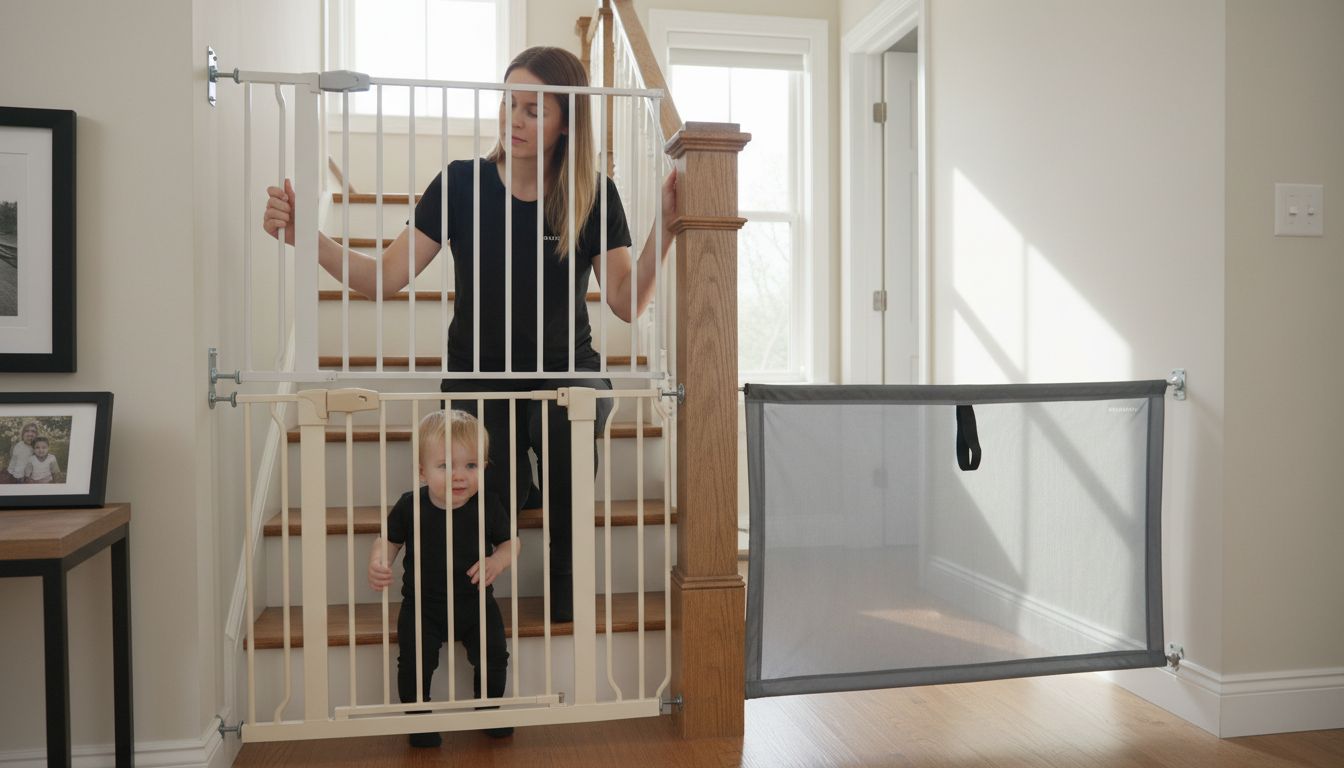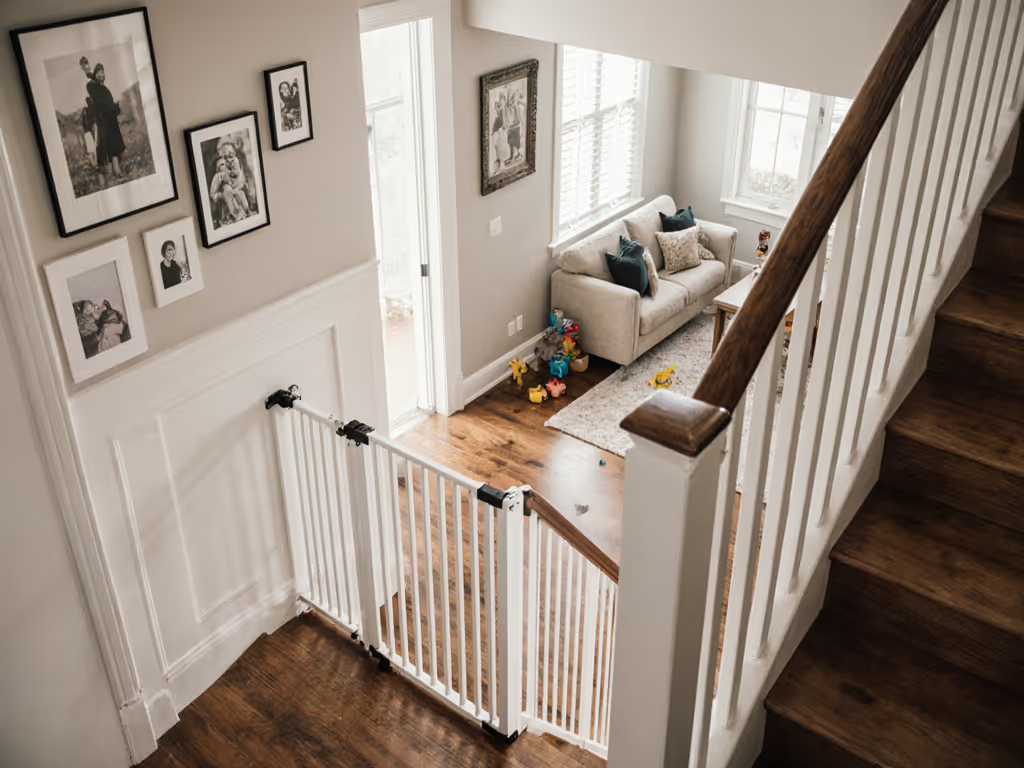
Why Baby Gates for Stairs Matter: Complete Guide

Every 6 minutes in the US, a child under 5 is treated for a stair-related injury. Stairs pose a unique threat to young children, as their curiosity often outpaces their coordination and awareness of danger. Without the right barriers in place, even a brief moment of inattention can lead to serious accidents. Understanding why stairs require special baby gate protection and choosing the safest options is vital for any parent looking to reduce household risks.
Key Takeaways
| Point | Details |
|---|---|
| Risks of Stairs | Stairs pose significant dangers for children, with high rates of head injuries highlighting the need for effective safety measures. |
| Hardware-Mounted Gates | These gates offer the best security for stair safety, recommended for both the top and bottom of stairs, ensuring children cannot access potentially dangerous areas. |
| Gate Installation | Proper installation and ongoing maintenance of baby gates are crucial to prevent accidents; parents must avoid common mistakes like using the wrong type of gate for stairways. |
| Comprehensive Safety Culture | Beyond choosing the right equipment, fostering safe behavior around gates is essential for maintaining a secure environment for children. |
Why Stairs Require Special Baby Gate Protection
Stairs represent one of the most dangerous environments for young children. Every 6 minutes, a child under 5 years old is treated in a U.S. emergency department for a stair-related injury – a startling statistic that underscores the critical need for proactive safety measures.
Children's natural curiosity and developing motor skills make stairs an especially high-risk zone. Toddlers and infants lack depth perception and coordination to navigate stairs safely, which means even a momentary lapse in supervision can result in potentially serious accidents. Stair falls can lead to head injuries, fractures, and traumatic impacts that could have long-term developmental consequences.
Hardware-mounted baby gates provide the most reliable protection in these scenarios. These gates are specifically designed to create a physical barrier that prevents children from accessing staircases unsupervised. Key safety features include:
- Sturdy mounting brackets that attach directly into wall studs
- Rigid construction that cannot be easily pushed or dislodged
- One-handed operation mechanisms for adult convenience
- Self-closing and auto-locking designs
Experts recommend installing baby gates at both the top and bottom of staircases as soon as a child can sit up independently. This comprehensive approach eliminates potential access points and dramatically reduces the risk of accidental falls. By investing in high-quality stair gates, parents can create a safer home environment and provide peace of mind during those critical early developmental years.
Types of Baby Gates for Stair Safety
Baby gates are not a one-size-fits-all solution, and understanding the different types is crucial for effective child safety. The primary categories include hardware-mounted gates, pressure-mounted gates, and retractable gates, each designed for specific locations and safety requirements within a home.
Hardware-mounted gates represent the gold standard for stair safety. These gates are permanently installed by screwing mounting brackets directly into wall studs, creating an immovable barrier that cannot be accidentally dislodged by a child's weight or pushing. They are specifically recommended for the top of staircases where the risk of serious injury is highest. Key characteristics include:
- Rock-solid attachment to wall structures
- No potential for unexpected movement or shifting
- Ideal for preventing falls in high-risk areas
- Designed to withstand significant pressure
Pressure-mounted gates offer more flexibility and are typically used in doorways or at the bottom of stairs. These gates use tension springs to create a tight fit between walls or door frames without requiring permanent installation. While convenient for temporary barriers, they are not recommended for top-of-stair locations due to potential instability under a child's weight.
Retractable and mesh gates provide another innovative option for parents seeking versatile safety solutions. These gates can be easily rolled out or folded away when not in use, making them popular in homes with limited space. However, they should only be used in low-risk areas and never as the primary safety barrier at the top of stairs. The key to effective baby gate protection is selecting the right type for each specific location and ensuring proper installation according to manufacturer guidelines.

Here's a comparison of baby gate types for stair safety:
| Gate Type | Installation Method | Recommended Location | Key Pros | Main Cons |
|---|---|---|---|---|
| Hardware-Mounted | Screwed into wall studs | Top & bottom of stairs | Maximum stability<br>Permanent barrier<br>High security | Requires drilling<br>Less portable |
| Pressure-Mounted | Tension between walls | Doorways<br>Bottom of stairs | No drilling needed<br>Portable | Not safe for stair tops<br>Can shift or loosen |
| Retractable/Mesh | Mounted with brackets<br>Rolls or folds away | Doorways<br>Low-risk areas | Space-saving<br>Easy to store | Not for stair tops<br>Less sturdy |
 |
|
Key Features of Stairway Baby Gates
Choosing the right baby gate goes far beyond simple aesthetics. Safety standards are paramount, with specific design requirements that can mean the difference between protection and potential injury. The Consumer Product Safety Commission (CPSC) has established critical guidelines to ensure child safety in gate design and construction.
Structural integrity represents the most fundamental feature of an effective stairway baby gate. This means looking for gates with specific design characteristics that minimize risk:
- Straight top edge to prevent climbing
- Rigid mesh or solid panel construction
- No V-shaped or diamond-shaped openings that could trap little fingers or limbs
- Smooth, rounded edges without sharp protrusions
Installation mechanisms play a crucial role in gate effectiveness. Hardware-mounted gates offer the most secure option, particularly for top-of-stair locations. These gates attach directly into wall studs, creating an immovable barrier that cannot be accidentally pushed or dislodged by a child's weight. Parents should look for gates with robust mounting brackets, preferably with multiple attachment points to distribute pressure and reduce wall damage.
Additional critical features include one-handed opening mechanisms, automatic closing systems, and clear visual indicators that the gate is properly locked. Some advanced gates now incorporate additional safety technologies like indicator lights or audible locks that signal when the gate is not fully secured. Remember, no single feature guarantees complete safety - careful selection, proper installation, and ongoing maintenance are key to creating a truly child-safe environment.
Risks of Unprotected Stairs for Children
Stairs represent one of the most treacherous environments for young children, transforming seemingly ordinary home architecture into a potential danger zone. Research reveals a shocking statistic: approximately 73% of stair-related incidents result in head and neck injuries, underscoring the critical importance of proactive safety measures.
Developmental limitations play a significant role in children's vulnerability to stair-related accidents. Young children lack several key cognitive and physical abilities that adults take for granted:
- Underdeveloped depth perception
- Limited spatial awareness
- Inconsistent balance and coordination
- Inability to assess potential falling risks
- Impulsive movement patterns
The potential consequences of unprotected stairs extend far beyond momentary bumps and bruises. Traumatic injuries can have long-lasting developmental impacts, including potential neurological complications, physical disabilities, and psychological trauma. Head injuries are particularly concerning, as they can disrupt critical brain development during a child's most formative years.
Beyond physical risks, unprotected stairs create constant psychological stress for parents and caregivers. The knowledge that a single moment of distraction could result in a potentially life-altering accident creates an environment of perpetual anxiety. Implementing comprehensive stair protection isn't just about preventing physical harm – it's about creating a safe, secure environment where children can explore and develop with minimal risk, and parents can feel confident in their home's safety infrastructure.
Common Mistakes in Baby Gate Use
Parents often underestimate the complexity of baby gate safety, making seemingly innocent mistakes that can compromise their child's protection. Installation errors represent the most critical and potentially dangerous mistakes that can transform a safety device into a potential hazard.
One of the most frequent and dangerous mistakes is improper gate selection. Many parents unknowingly use gates that are inappropriate for specific locations, particularly at staircase entrances. Key mistakes include:
- Using pressure-mounted gates at the top of stairs
- Selecting outdated accordion-style gates with dangerous V-shaped openings
- Failing to check current safety standards and certifications
- Neglecting regular gate maintenance and inspection
- Assuming all gates are equally safe for all locations
Mounting and installation errors compound the risks associated with inappropriate gate selection. Incorrect installation can create gaps, instability, or potential climbing opportunities for curious children. Parents must carefully follow manufacturer instructions, ensuring gates are securely mounted with appropriate hardware and positioned to eliminate potential bypass routes.
Beyond physical installation, behavioral mistakes can render even the best baby gates ineffective. These include leaving gates partially open, failing to consistently close and lock gates, and not training older children and caregivers about proper gate usage. The key to effective baby gate protection lies not just in the product itself, but in creating a comprehensive safety culture within the household.
Protect Your Child with the Right Stair Baby Gate Today
The article explains how unprotected stairs pose serious risks due to children's developing coordination and curiosity. Many parents face the challenge of selecting and installing the right safety gate that fits their home and truly prevents accidents on stairs. Common pitfalls like using pressure-mounted gates at the top of stairs or outdated designs increase danger instead of reducing it. Your goal is to create a secure environment where your child can explore safely without constant fear or stress.
At BabySafetyGates.World, you will find expert guidance tailored specifically for stair safety. From detailed reviews of hardware-mounted gates that provide maximum stability to practical installation tips meeting the latest safety standards, this resource is designed to help you make informed decisions that truly protect your little one. Do not wait until an accident happens. Explore our comprehensive buying guides and comparison tools to find the best stair gates for your family and learn how to install them correctly. Visit us now at https://babysafetygates.world and take the first step toward safer stairs today.
Frequently Asked Questions
Why are hardware-mounted baby gates recommended for stairs?
Hardware-mounted baby gates provide maximum stability because they are securely attached to wall studs, creating an immovable barrier. This makes them ideal for high-risk areas like the top of stairs where the potential for serious injury is highest.
What are the main safety features to look for in a stairway baby gate?
Key safety features include a straight top edge to prevent climbing, rigid construction, smooth rounded edges to minimize injury risk, and one-handed operation mechanisms for convenience. Additionally, self-closing and auto-locking designs enhance safety.
What are the risks of using pressure-mounted gates at the top of stairs?
Pressure-mounted gates are not recommended for the top of stairs because they can shift or loosen under a child's weight, posing a significant risk of falls and injuries. They are best suited for doorways or the bottom of stairs.
How can parents ensure the effective use of baby gates in their home?
To ensure effective use, parents should properly follow installation instructions, regularly inspect and maintain the gates, avoid leaving them open, and educate older children and caregivers about safe gate procedures.




